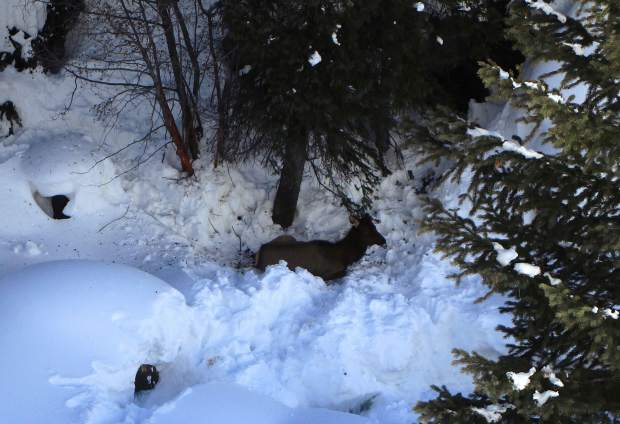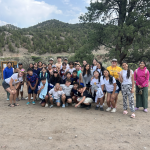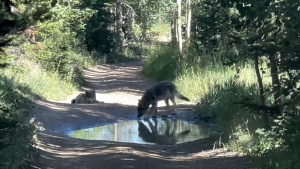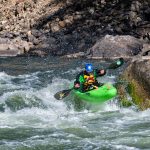Minturn elk herd is declining

By the aerial count*
1,000: Elk counted near Minturn in the mid-1990s.
981: Elk counted in 2002.
829: Elk counted in 2004.
162: Elk counted in 2014.
*Numbers are from aerial counts, and aren’t definitive. Source: Colorado Parks and Wildlife.
MINTURN — It seems like fewer elk are wintering on the east side of the Eagle River here this winter. That’s because Minturn’s elk herd has been in decline for more than a decade.
About 20 years ago, Colorado Parks & Wildlife counted roughly 1,000 elk near Minturn. Extrapolating from that aerial count, officials estimated a population of roughly 1,700 animals in the area.
Today, the best guess is that 604 elk are in what the state calls Game Management Unit 45 in the Minturn area.
Longtime Minturn resident Valerie Wegert’s home is hard against the river, with views across the stream.
“We used to see a lot (of elk) up above the hill,” Wegert said. “But for maybe the part of four or five years, we haven’t seen them as much.”

Support Local Journalism
What happened?
Colorado Parks & Wildlife Area Manager Perry Will oversees the department’s operations in Pitkin, Garfield and Eagle counties. Will said the decline in Minturn’s elk herd is due to a few factors.
Nature is the eternal herd-limiter.
Winter limits food available to animals, and a combination of natural predators and harsh conditions thin herds every winter. A particularly cold, snowy winter, especially at high elevations, can take a particularly harsh toll on populations. While the calving seasons in 2011 and 2012 showed good numbers of cow/calf pairs, Will said this winter has been a hard one.
The biggest factor in animal populations, though, is people encroaching on elk habitat. That impact comes in a number of forms, from homes shrinking habitat to skiers and snowboarders trying to get close to the animals, even for photos.
“There’s just a lot more people these days,” Will said.
Winter weakness
Already weakened by winter, forcing an animal to run will weaken it further, making it more susceptible to disease, cold weather or predators.
“They need the least amount of disturbance,” Will said. “Somebody will want a picture and (the elk) will run off. … The frequency of disturbance is far too much. The frequency and duration (of disturbances) all has an effect.”
Severely weakened adult elk are also less likely to have healthy offspring, Will said.
“Any place that’s wintering big game, the less you can disturb them the better,” he said.
Carrie Rose Morris is the sales and marketing director of Vail Backcountry Tours. That company runs snowmobile tours north and west of Vail.
Morris said there aren’t many elk where her company runs tours, but there are moose. And, she said, wildlife awareness is a big part of the company’s business model.
“Our guides are very experienced,” Morris said. “If they spot wildlife, they’ll call it out on the radio, and we’ll try to avoid getting close. We try not to affect their life.”
Morris said if a client asks to get closer for a better photo, the answer, always, is “no.”
While the Minturn elk herd may be the most depleted, Will said herds throughout the region have been affected by human interference. Will said herds are depleted in the Roaring Fork Valley. And, while it seems there are a lot of elk around the town of Eagle, the herds there are in decline, too.
Herds north of Eagle are doing pretty well, Will said, but the populations are declining south of town up the Brush Creek drainage.
Can herds rebound?
But, Will said, wildlife fences along Interstate 70 seem to have been a benefit to the animals.
While fences limit animals’ mobility, Will said that beats the alternative.
“I’d rather have a live (elk) on one side of the fence than a dead one in the road,” he said.
While elk are declining around the populated areas of northwestern Colorado, Will said the region — which includes wilderness areas and a lot of wide-open spaces with few humans — still accounts for 60 percent of the entire state’s elk harvest every year.
The forests and backcountry around this region have long been popular with both local and out-of-state hunters. But, as elk populations have declined, fewer hunting permits have been issued in certain game management areas, Will said.
While the elk herd is declining, wildlife officials hope to encourage a comeback. That’s been done before, and in a big way. By the first decade of the 20th century, elk in Colorado had been hunted nearly to extinction. With management, the species came back strong.
“We want more elk (at Minturn),” Will said. “That’s how (the department) survives.”
Vail Daily Business Editor Scott Miller can be reached at 970-748-2930, smiller@vaildaily.com and @scottnmiller.











